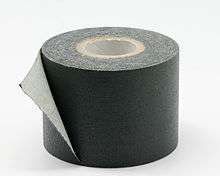Gaffer tape


Gaffer tape (also known as gaffer's tape or gaff tape[1] as well as camera tape and spike tape for narrow, coloured gaffer tape) is a heavy cotton cloth pressure-sensitive tape with strong adhesive properties. It is widely used in theatre, photography, film and television production, and industrial staging work.
While similar to and often confused with duct tape, it differs in the composition of both the backing, which is made from fabric as opposed to vinyl or other plastics, and the adhesive, which is usually rubber-based, more resistant to heat and allows easier removal without damaging the surface to which it was adhered.[2][3][4]
The precise origin of the name is unknown, one theory being that it is named for the gaffer (chief lighting technician) on a film crew.[5] When cables are taped down on a stage or other surface, either to prevent tripping hazards or conceal them from view of the audience or camera,[6] they are said to be gaffed or gaffered.[7][8][9]
The original manufacturer was the Permacel division of Johnson & Johnson,[10] and until the brand's discontinuation by the current owner, was both the preferred brand and a generic reference used in the film, stage, and TV industries.
Properties and uses

Gaffer tape is manufactured in many colors, including fluorescent and custom colors, but perhaps the most common variety is matte black. A matte finish keeps the tape from reflecting light so it blends in with a typical stage floor. It is sold in a variety of widths from 1⁄4 in (6 mm) to 4 in (102 mm), with 1 in (25 mm) and 2 in (51 mm) being the most common. Gaffer tape is strong yet can be torn by hand, so no cutting tools are necessary, and it can easily be ripped into narrower strips when desired. The synthetic adhesive typically leaves little or no residue and will generally not damage most surfaces when it is removed. This is, however, more likely in warm conditions, so care must be used in considering whether a different type of tape would be more appropriate in a given application. Gaffer tape is usually more expensive than duct tape because it is manufactured in smaller quantities, has more exacting specifications, and is marketed for professional use.[4][5][11]
A common application for gaffer tape is securing cables to a stage floor, podium, or other surface, either for safety or concealment. It is also frequently used whenever a quick ad hoc fix is required, from temporarily attaching fixtures or props, to salvaging a broken piece of production equipment. A narrow version of gaffer tape, called spike tape, is used in theater productions for floor layout. [4][12]
In the absence of console tape or artist tape, live sound engineers or lighting board operators may use a strip of white gaffer tape along the bottom of a mixing board, to label the channels or submasters used for a particular show.[5]
It is also widely used by audio-visual departments in hotels and conference centers for affixing cables to podiums and stages.[4] It can also be used as a waterproof packaging tape and some grades even meet packaging certification standards such as ASTM D5486.
Gaffer tape is also often used for the marking of indoor climbing routes.
Standards
- PPP-T-60E Type IV Class I (canceled in 1995 and replaced by ASTM D5486M)
- ASTM D5486M Type IV Class I
- ASTM 1586A
See also
References
- ↑ Lawler, Mike (2007), Careers in Technical Theater, Allworth Communications, Inc., p. 97, ISBN 9781581154856
- ↑ Cool Tool: Gaffer's Tape, retrieved 2007-10-29
- ↑ "Quick Tip: Gaffer's Tape". blog.reallyrightstuff.com. Retrieved 23 February 2015.
- 1 2 3 4 "Whats Gaffers Tape Used for?". www.gafftapes.com. Retrieved 23 February 2015.
- 1 2 3 "What is Gaffer's Tape?". wiseGEEK. Retrieved 22 February 2015.
- ↑ Church of the Holy Gaffer Tape - Top Tips for Gaffer Tape, archived from the original on 2007-11-12, retrieved 2007-10-29
- ↑ "Gaffing cable to the floor". ControlBooth. Retrieved 2016-03-09.
- ↑ "Technical Terms: Gaff". ControlBooth. Retrieved 2016-03-09.
- ↑ "Make Do and Mend". ShowStudio. Retrieved 2016-03-09.
- ↑ "Where did gaffers tape come from?". Retrieved 15 September 2015.
- ↑ "WHAT IS GAFFER TAPE?". www.setelectrics.com. Retrieved 23 February 2015.
- ↑ "Types Of Tape (And Not The Recording Type) For Audio/Production". www.prosoundweb.com. Retrieved 23 February 2015.
External links
| Wikimedia Commons has media related to Gaffer tape. |
- Expendables at DMOZ
- https://www.controlbooth.com/threads/changes-in-permacel-gaffers-tape.5085/ thread on changes and varieties